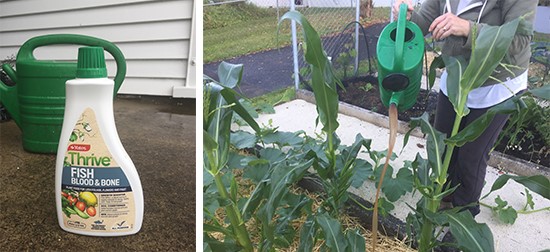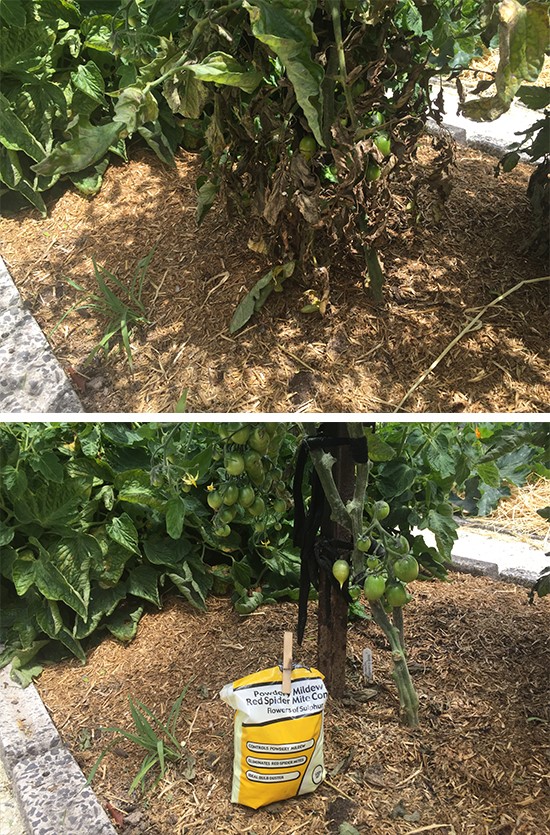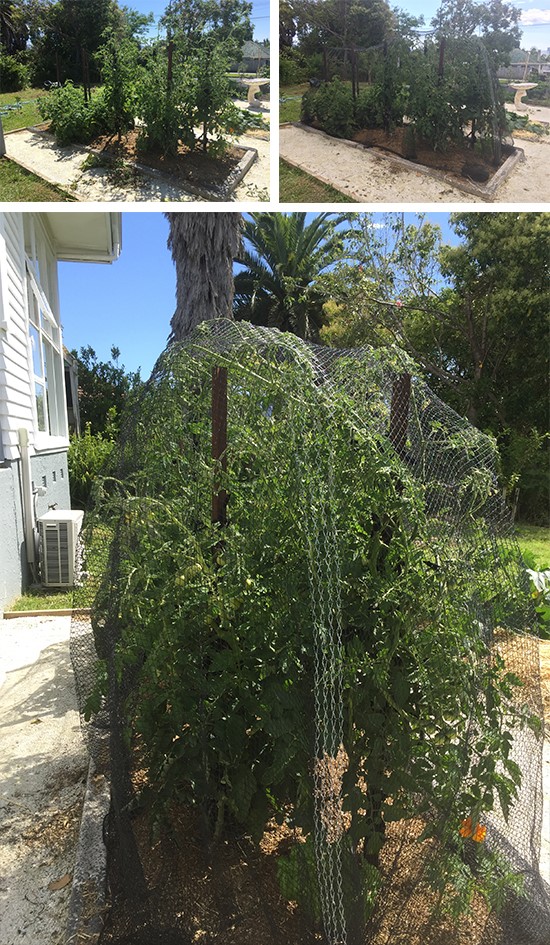
After continuous heavy rain and damaging winds, it’s now all lovely and peaceful, just in time for Christmas!
The rain couldn’t have arrived in a better moon phase really, as the plan for this week, being the Last Quarter, was feeding and mulching and both of those are best done after watering.
With the chips from the pruning of our guava tree, hubby mulched round the feijoa hedge. This will help retain the moisture over the summer months.

Then I got feeding, very specifically. My sweetcorn is producing cobs but is not as tall as Rob reckons sweetcorn should be and that only means on thing – not enough food.

I had a bottle of Fish and Blood and Bone kindly donated to me by Yates. This is a good potent liquid feed. The dosage is 1-2 capfuls per 9ml watering can, but I added in one extra capful, as Rob says you can’t give sweetcorn too much food. I watered it all over the leaves and soil because it was a dull day and more rain was forecast. We wouldn’t recommend watering over the leaves in broad sunshine. Blood and Bone has only N (nitrogen) and P (phosphorus) in it, so it’s great for leafy green plants. I’ll see if this makes a difference and then either apply in 2 weeks’ time if not, and 4 weeks’ time if it does.

Next we applied Yates Fish and Seaweed on the capsicums and eggplants with their new mulch around them (big enough now to have their net off and the watermelon needs to get rambling). Rob and I thought this was the best choice for these fruiting plants. But we still like our stinky comfrey brew best on the tomatoes and beans, so they didn’t get any of the Fish and Seaweed.
You can make these solutions yourself of course with seaweed collected from the beach and fish scraps from the fishmonger.

Straight Liquid Seaweed from Ocean Organics (Agrisea) went on the zucchini, cucumber and pumpkin to feed them but also to help prevent powdery mildew forming on the leaves of these plants (which it’s very likely to do in our humid conditions). I’ll repeat this application of seaweed ongoing every two weeks in this overcast damp weather we’re having at the moment. When it becomes clear and dry it doesn’t need doing any more than monthly.

And finally to the tomatoes. The base of the indeterminate varieties is getting a bit scraggly, so I’ve delateralled those branches and applied Flowers of Sulphur to those wounds, since some of the wounds were quite big.

Then, as you can see, they’re growing above our stakes (note to self to invest in some taller waratahs next year). I face the dilemma of leaving them to grow unfettered and give the birds free access, or wrap them up in netting and tuck the towering growth in under the netting. I have chosen the latter.

Oh and I had to find out some time soon, so I bandicooted the Rocket potatoes and found some sweet little fresh new potatoes. Phew! Good to know they’re there for Christmas Day!

So, a few words from Rob, by popular demand…
“Remember to plant flowers in your garden. I think a quarter of your plants should be flowers. They don’t have to be all in one space, just put a flowering plant in where you have a gap. They encourage the beneficial insects and bees into your garden and create balance in nature. Have a water source for the bird, bees and insects too. And enjoy your garden – many people these days are just too busy to stop and take in the wonder of nature, but you’ll be better off if you do.”
We wish you a wonderful Christmastime full of peace and love and homegrown kai with your family and friends. See you in 2020!
From Jan, Rob and the Team at OEG

Website designed by www.thecornerstorecollective.com
Developed by Richard Hpa
4 Responses
I learn so much from your posts. thanks so much for an informative year. Have a wonderful Christmas
Thank you Erica 🙂
Hi,
I hope you all had a merry Christmas and a restful break.
What do you and Rob recommend is the best crop rotation…..3 years or 4 years?
I’m confused by information on both and can’t decide which one to follow.
Kind regards,
Christine
Hi Christine We recommend not putting the same crop in a bed for 4 rotations. In our temperate climate that takes 2 years because you count the summer and winter crops as 2 rotations. In more extreme Northern Hemisphere climates they don’t plant winter crops outside, therefore it will take 4 years (4 summer rotations) to be able to plant the same crop in the one bed. Hope that helps clarify things. All the best 🙂